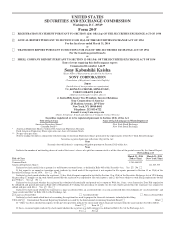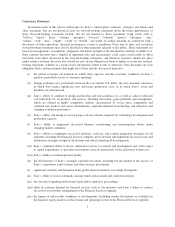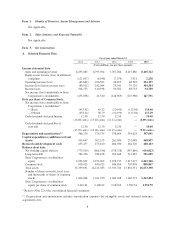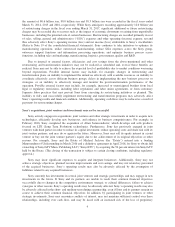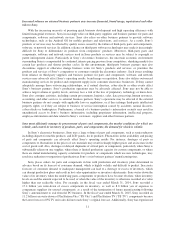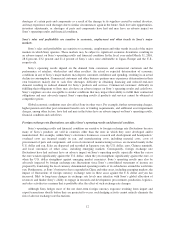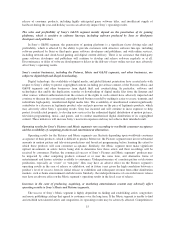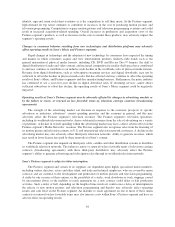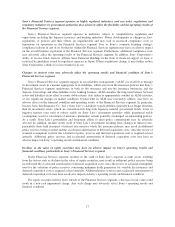Sony 2015 Annual Report Download - page 11
Download and view the complete annual report
Please find page 11 of the 2015 Sony annual report below. You can navigate through the pages in the report by either clicking on the pages listed below, or by using the keyword search tool below to find specific information within the annual report.Increased reliance on external business partners may increase financial, brand image, reputational and other
risks to Sony.
With the increasing necessity of pursuing quick business development and high operating efficiency with
limited managerial resources, Sony increasingly relies on third-party suppliers and business partners for parts and
components, software and network services. Sony also relies on other business partners to provide software
technologies, such as the Android OS for mobile products and televisions, and services. As a result, Sony’s
products or services may be affected by quality issues caused by the failure of third-party parts and components,
software, or network services. In addition, reliance on third-party software technologies may make it increasingly
difficult for Sony to differentiate its products from competitors’ products. Moreover, third-party parts and
components, software and network services used in Sony products or services may be subject to copyright or
patent infringement claims. Particularly in Sony’s electronics businesses, the uncertain economic environment
surrounding Sony is compounded by continued, intense pricing pressure from competitors, shrinking markets for
certain key products and shorter product cycles. In this environment, third-party business partners may also
discontinue support or otherwise change business terms for Sony’s products and services, or prioritize the
products and services of Sony’s competitors or customers outside the electronics industry. Such issues resulting
from reliance on third-party suppliers and business partners for parts and components, software, and network
services may adversely affect Sony’s operating results, brand image or reputation. Sony also utilizes outsourced
manufacturing services for product and component supply in its consumer electronics businesses. If Sony cannot
adequately manage these outsourcing relationships, or if natural disasters, cyber-attacks or other events affect
Sony’s business partners, Sony’s production operations may be adversely affected. Sony may not be able to
achieve target volume or quality levels, and may face a risk of the loss of proprietary technology or know-how.
Sony also consigns activities, including certain procurement, logistics, sales, data processing, human resources,
accounting, and other services, to external business partners. Sony’s operations may be affected if the external
business partners do not comply with applicable laws or regulations, or if they infringe third-party intellectual
property rights, or if they are subject to business or service interruption caused by accidents, natural disasters,
cyber-attacks or bankruptcies. Furthermore, a breach of a business partner’s information security may result in
unauthorized access to Sony’s business information, including proprietary information, intellectual property,
employee information and data related to Sony’s customers, suppliers and other business partners.
Sony must efficiently manage its procurement of parts and components, the market conditions for which are
volatile, and control its inventory of products, parts, and components, the demand for which is volatile.
In Sony’s electronics businesses, Sony uses a large volume of parts and components, such as semiconductors
including chipsets for mobile products, and LCD panels, for its products. Fluctuations in the availability and pricing
of parts and components can adversely affect Sony’s operating results. For instance, shortages of parts or
components or fluctuations in the prices of raw materials may result in sharply higher prices and an increase in the
cost of goods sold. Also, shortages or delayed shipments of critical parts or components, particularly where Sony is
substantially reliant on one supplier, where there is limited production capacity for custom components, or where
there are initial manufacturing capacity constraints for products or components which use new technologies, may
result in a reduction or suspension of production at Sony’s or its business partners’ manufacturing sites.
Sony places orders for parts and components in line with production and inventory plans determined in
advance based on its forecast of consumer demand, which is highly volatile and difficult to predict. Inaccurate
forecasts of consumer demand or inadequate management can lead to a shortage or excess of inventory, which
can disrupt production plans and result in lost sales opportunities or inventory adjustments. Sony writes down the
value of its inventory when the underlying parts, components or products have become obsolete, when inventory
levels exceed the amount expected to be used, or when the value of the inventory is otherwise recorded at a value
higher than net realizable value. For example, in the fiscal year ended March 31, 2014, Sony recorded a
17.4 billion yen write-down of excess components in inventory, as well as 8.0 billion yen of expenses to
compensate suppliers for unused components, as a result of the termination of future manufacturing following
Sony’s announcement to exit from the PC business. In the fiscal year ended March 31, 2015, Sony recorded an
11.2 billion yen write-down of PlayStation®Vita (“PS Vita”) and PlayStation TV (“PS TV”) components because
the latest forecast of PS TV unit sales did not reach Sony’s original forecast. Additionally, Sony has experienced
11

